Things aren't going too well in this tiny California
town - not only is the local bully/rancher trying to take over
the ranch owned by the town doctor and his family, but there's
some sort of mysterious illness sweeping the town. The sickness
only affects young women, causing them to waste away, and in
the three previous cases it's proven fatal.
As the movie begins, however, the latest victim
appears to be getting better. The embattled Doc Carter (John
Hoyt) wisely lays her recovery more to the nighttime prayer
vigil held at her bedside by the local preacher, Dan (Eric Fleming),
than his medicine. 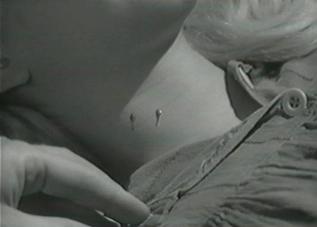 The
relieved parents take the two men into the kitchen to have a
celebratory breakfast; their jubilation is cut short by the
girl's cry. As they burst into her bedroom, no one notices the
window shutter rattling open - all eyes are on the still, lifeless
form on the bed. As Doc ushers the distraught parents out, Dan
prays over the body - and notices two small puncture marks on
her neck wet with blood.
The
relieved parents take the two men into the kitchen to have a
celebratory breakfast; their jubilation is cut short by the
girl's cry. As they burst into her bedroom, no one notices the
window shutter rattling open - all eyes are on the still, lifeless
form on the bed. As Doc ushers the distraught parents out, Dan
prays over the body - and notices two small puncture marks on
her neck wet with blood.
Doc and his daughter Dolores (Kathleen Crowley)
return to their ranch only to find young Tim (Jimmy Murphy)
strapping on his guns. Seems the local bully rancher, Buffer,
has dammed up the river that feeds the Carters' cattle - and
when Tim demanded that Buffer undam the river, the rancher had
his henchmen rough him up. Doc orders Tim back into the house,
and drives into town to enlist the aid of the Sheriff (Ed Binns).
While the Sheriff is in the local saloon, facing
down Buffer (Bruce Gordon) and his thugs, Doc drives his carriage
back to his ranch, unaware that a sinister figure in dark clothing
and black leather is following him... and when the carriage
arrives at the Carter ranchhouse, there is a dead man at the
reins.
After Doc's funeral, a hired hand tells Tim that
Buffer's men have cut a section of fence and taken off with
eighty head of cattle. The hotheaded Tim heads to the saloon,
and after a lengthy bout of liquoring up, challenges Buffer
to a gun fight. Despite the Sheriff's intervention, Tim goads
Buffer into drawing, and the older man, not only more experienced
but sober, kills him. The next day, Dolores - the sole surviving
member of the Carter family - starts hanging up posters offering
"$100 for the Death of a 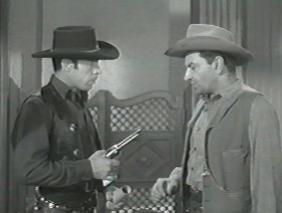 Murderer".
The Sheriff follows her, pulling each one down - but one still
finds its way into the hands of that black-leathered figure.
Murderer".
The Sheriff follows her, pulling each one down - but one still
finds its way into the hands of that black-leathered figure.
The figure saunters into the Saloon - Buffer's
hangout - with the poster in hand. He is Drake Robey (Michael
Pate), gun for hire, and he aims to talk to Miss Dolores about
this job. One of Buffer's men draws on the gunman, but although
he shoots first, Robey still shoots the gun out of his hand
and walks away unharmed. Angered, Buffer fires the thug on the
spot - although the astonished man insists he hit Robey.
At the Carter ranch, Preacher Dan is going through
Doc's strong box, trying to find the dead man's will. He tells
Dolores he'll take it to town and do a more complete search
of the papers; and this is where the script finally decides
to tell us that Dan and Dolores are in love with each other.
Robey arrives and offers his services; when Dolores accepts
his offer, Dan angrily leaves. That night, Robey visits the
sleeping Dolores, and bends slowly to her neck....
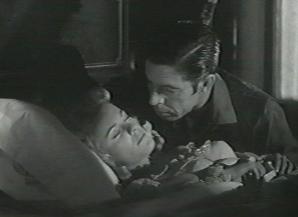 Searching
through the papers, Dan finds a secret compartment containing
the diary of Don Robles, the Spanish nobleman who sold the ranch
to Doc Carter after "some sort of family tragedy".
The diary spells out the tragedy all too clearly: the Don had
sent his eldest son, Drago, to Madrid on business, and when
he returned, he found his bride in the arms of his brother.
Drago stabbed his brother to death, and later, in a fit of grief,
committed suicide in the family tomb. Three nights later, a
shadowy figure visited the bedside of Drago's new widow, and
hearing her cries, the Don broke into the room and grappled
with the intruder - and to his horror, found himself staring
into the face of his dead son.
Searching
through the papers, Dan finds a secret compartment containing
the diary of Don Robles, the Spanish nobleman who sold the ranch
to Doc Carter after "some sort of family tragedy".
The diary spells out the tragedy all too clearly: the Don had
sent his eldest son, Drago, to Madrid on business, and when
he returned, he found his bride in the arms of his brother.
Drago stabbed his brother to death, and later, in a fit of grief,
committed suicide in the family tomb. Three nights later, a
shadowy figure visited the bedside of Drago's new widow, and
hearing her cries, the Don broke into the room and grappled
with the intruder - and to his horror, found himself staring
into the face of his dead son.
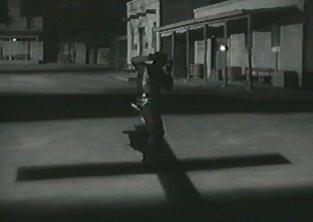 Yes,
Dan finally knows what we've known for quite some time: that
Drake Robey is really Drago Robles, a vampire who has been preying
on local girls and now hides during the day in Doc Carter's
coffin. Hard upon the heels of this discovery, Robey kills the
Sheriff, and Dan notices the two punctures on the man's neck.
Leaving the Sheriff's office, the preacher finds himself pursued
by someone lurking in the shadows, and panicking, runs to the
church. This is his salvation, as he sees Robey cringe physically
as the shadow of the cross on the church's steeple, etched in
the bright moonlight, falls across him. Now Dan has to convince
Dolores of the true nature of Robey, and find a way to destroy
him...
Yes,
Dan finally knows what we've known for quite some time: that
Drake Robey is really Drago Robles, a vampire who has been preying
on local girls and now hides during the day in Doc Carter's
coffin. Hard upon the heels of this discovery, Robey kills the
Sheriff, and Dan notices the two punctures on the man's neck.
Leaving the Sheriff's office, the preacher finds himself pursued
by someone lurking in the shadows, and panicking, runs to the
church. This is his salvation, as he sees Robey cringe physically
as the shadow of the cross on the church's steeple, etched in
the bright moonlight, falls across him. Now Dan has to convince
Dolores of the true nature of Robey, and find a way to destroy
him...
Yeah, I like the movie enough to not tell you
what happens next.
Curse of the Undead is an interesting film,
done in the heyday of Universal's b-movie machine, when the
studio seemed to turn out odd little gems like Tarantula!,
The Leech Woman, Monster on the Campus and The
Monolith Monsters once a week. Though the production
is pretty poverty-stricken and studio-bound on most fronts,
it's the confluence of a trend in the then-staid western with
an intriguingly traditional approach to the vampire mythos
that should make this movie better known than it is.
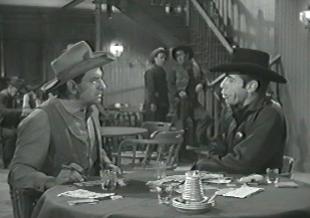 Though
nowhere near as deconstructive as the much later Unforgiven,
the late fifties saw the rise of the Psychological Western,
as the genre tried to expand past its boundaries to become more
than mere entertainment, to try to say something important about
the Human Condition; important films like The Searchers
brought a depth and realism to its characters that had been
missing in a field largely crowded with cardboard characters
moving about with predestined motivations.
Though
nowhere near as deconstructive as the much later Unforgiven,
the late fifties saw the rise of the Psychological Western,
as the genre tried to expand past its boundaries to become more
than mere entertainment, to try to say something important about
the Human Condition; important films like The Searchers
brought a depth and realism to its characters that had been
missing in a field largely crowded with cardboard characters
moving about with predestined motivations.
Curse benefits from this trend by elevating
itself above the trite range war backstory. Buffer is a bully,
true, but smart enough to listen to the Sheriff when the lawman
urges him to simply walk away from the drunken Tim - at least
until the young man's insults cause him to turn and fire. He
also knows he's outmatched by Robey, and willingly agrees to
a stiff penalty system proposed by Preacher Dan that will wreck
him financially if anything else ever befalls the Carter Ranch
- if only Dolores will send away her hired gun. The Sheriff
is portrayed as a working stiff who generally tries to talk
his way through the brooding conflicts around him, but shows
a fair amount of backbone when he walks into the lion's den
of Buffer's Saloon.
Sadly, our other majors are a fairly uninspiring
lot. Dolores is a stronger female character than one usually
finds in a horror movie of this vintage, but most of her decisive
action stems directly from anger and grief - when she's not
exhibiting either of those emotions, she seems amiable to just
about anything Dan says.
Speaking of Dan, the hero
is, as usual, a fairly boring sort, all uprightness and deep
voice. When you get right down to it, most heroes aren't very
fun to play - they usually can't be interesting enough to give
an actor any leeway in interpretation. The Leading Man in movies
like this requires a very special performer. Handsome and well-spoken
enough that the audience feels comfortable identifying with
him, but unextraordinary enough to encourage that identification.
Here the duty falls to Eric Fleming, whom those of you more
drawn to sci-fi will recognize from Queen of Outer Space
or George Pal's Conquest of Space. But those who
like their westerns will recognize him from his long, successful
run as trail boss Gil Favor on the old series Rawhide,
opposite a very young Clint Eastwood*.
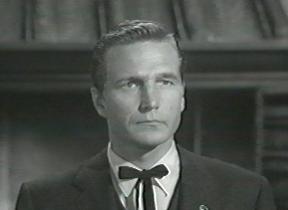 As
a leading man, Fleming was more than serviceable, and manages
to play Preacher Dan - a man with not only the wisdom of Solomon,
but a strength of faith normally reserved for saints - with
a sureness that allows us to accept the character as a real
person. The spiritual center of this small community (so small
it's rather a shock when we finally see a crowd scene near the
end), yet a man of his time, who resolutely straps on a gun
belt when it is finally time for a showdown with his new Nemesis.
We all wanted to be people like that when we were kids. Fleming
died a tragic early death in 1966 while filming a movie in Peru
- while I don't think he was good enough to eventually supplant
any of Hollywood's idols, he still had a lot of B-movies ahead
of him, and that black-and-white universe was darker without
him.
As
a leading man, Fleming was more than serviceable, and manages
to play Preacher Dan - a man with not only the wisdom of Solomon,
but a strength of faith normally reserved for saints - with
a sureness that allows us to accept the character as a real
person. The spiritual center of this small community (so small
it's rather a shock when we finally see a crowd scene near the
end), yet a man of his time, who resolutely straps on a gun
belt when it is finally time for a showdown with his new Nemesis.
We all wanted to be people like that when we were kids. Fleming
died a tragic early death in 1966 while filming a movie in Peru
- while I don't think he was good enough to eventually supplant
any of Hollywood's idols, he still had a lot of B-movies ahead
of him, and that black-and-white universe was darker without
him.
But even with a fairly intelligent script and
solid cast, this western would sink into the obscurity currently
inhabited by many of its brethren, if not for the element of
the fantastic at its core: the vampire, Drake Robey, or Drago
Robles. Past the almost requisite, almost cutesy-poo touch of
naming its villain Drake or Drago, with its linguistic
similarities to the more infamous Dracula, director/writer
Edward Dein and his wife Mildred are to be commended for bucking
what could be considered Common Knowledge and returning to the
source for their internal mythos: Spanish folklore.
Everyone carries a stock set of notions that "Everybody
Knows"; when it comes to genre films, a lot of these notions
can be traced back to the Universal horror classics of the 30's.
Curt Siodmak, in writing The Wolf Man, created an entire
mythology around werewolves that is still accepted as rote today:
the full moon, the silver bullets, the pentagrams, the "curse"
of lycanthropy transmitted through the bite - Siodmak gathered
a little here, a lot there, made up some stuff... and thus I
get traumatized when I see Curse of the Werewolf at age
12 because Oliver Reed doesn't operate like Larry Talbot.
Most of what we know about vampires comes down
to us through Bram Stoker's Dracula (the book, not the
Coppola movie. And never mention the name of that... that thing
in my presence again!); from there through the Universal pictures,
the Hammer Films... the truth is, minimal research will show
you that there are as many different types of vampires as there
are countries, and each locale puts its individual spin on the
creature. The Wurdalak, featured in Black Sabbath, who
can only drink the blood of family; the Baobhan Sith,
who entice travelers to dance by their side until the victims
unknowingly bleed to death; the Philippine Aswang,
with a taste for unborn children; all vampires of one stripe
and another, one origin and another.
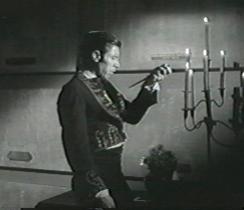 By
returning to European roots, this vampire movie rids itself
of several typical vampire tropes that would have only served
to cause it to be compared with all other vampire flicks, especially
the Hammer horrors that were starting to come into vogue at
about this time. Drake is a vampire because he committed the
mortal sin of suicide - traditionally suicides were buried at
crossroads to prevent them from returning as vampires. Because
of this, none of Robey's victims will be returning from the
dead; without the subplot of seeking out the vampire's "brides"
and putting them to rest, we are left to concentrate only on
the conflict between Robey and Dan.
By
returning to European roots, this vampire movie rids itself
of several typical vampire tropes that would have only served
to cause it to be compared with all other vampire flicks, especially
the Hammer horrors that were starting to come into vogue at
about this time. Drake is a vampire because he committed the
mortal sin of suicide - traditionally suicides were buried at
crossroads to prevent them from returning as vampires. Because
of this, none of Robey's victims will be returning from the
dead; without the subplot of seeking out the vampire's "brides"
and putting them to rest, we are left to concentrate only on
the conflict between Robey and Dan.
Robey is also free to walk to walk the land during
the hours of daylight, which outrages many viewers of this movie.
According to some legends, yes, vampires can do this. They are
weakened and the light's too damned bright, but they can do
it. Lacking also (by and large) are the traditional hypnotic
powers of the Hollywood vampire. Though at one point Dolores
sleepwalks out to a waiting Robey, the vampire seems almost
surprised to find her so; mere moments before, in her bedroom,
he had resisted biting her a second time, as he has become truly
attracted to the woman. No, for the most part, Robey relies
upon his skill as a smooth talker (that is, when he doesn't
have to worry about not being the fastest draw in the room -
so what if he gets shot?).
When Dolores is convinced to discharge the gunslinger
of his murderous duty, he plays upon her sympathies by explaining
that he has a degenerative eye condition, and cannot stand daylight;
thus he convinces her to hire him on as a sort of night watchman,
so he can begin to earn an honest living. Thereafter, convinced
she is helping a bad man reform (a tragic misapprehension which
has 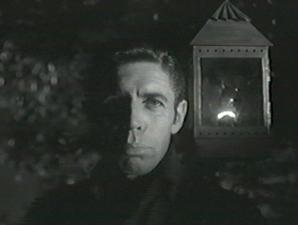 been
the downfall of too many of my female friends), Dolores defends
him at every turn, even as her confusion mounts and her relationships
with all around her deteriorate.
been
the downfall of too many of my female friends), Dolores defends
him at every turn, even as her confusion mounts and her relationships
with all around her deteriorate.
His prevarication falls short, however, when confronted
with the pure, straight-and-narrow capital-R Right of Dan. At
separate times, when Robey compares his trade to that of a professional
soldier, or claims that he is a creature more to be pitied than
despised, Dan's ultra-conservative rhetoric immediately reveals
the gunfighter's rationalizations for the pathetic lies they
are. Hell, if Dan were running for President, chances are I
would vote for him, and my politics lie somewhere to the left
of Captain Nemo.
If Robey's Spanish roots dispel the usual weaknesses
attributed to the vampire, his Catholic background leaves him
wide open to at least one of those traditional vulnerabilities:
the Christian cross. When he first meets Preacher Dan, the vampire
is dazzled by a bright light issuing from a button worn on Dan's
lapel - a light which only Robey can see. When Dan explains
that the cross upon the button was supposedly carved from a
thorn found at the site of the 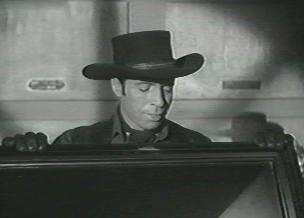 Crucifixion,
Robey's true nature is confirmed to the audience - as if we
had any doubt! (The eerie theremin music that underscores each
of his early appearances was also quite helpful) That said,
the role is helped immeasurably by veteran bad guy Michael Pate's
even-handed, matter-of-fact performance; he never gives in to
the mwoo-hah-ha evil possibilities evident in the role,
but maintains a believable menace behind a steady, almost charming
mask. I know guys like this, and you do, too.
Crucifixion,
Robey's true nature is confirmed to the audience - as if we
had any doubt! (The eerie theremin music that underscores each
of his early appearances was also quite helpful) That said,
the role is helped immeasurably by veteran bad guy Michael Pate's
even-handed, matter-of-fact performance; he never gives in to
the mwoo-hah-ha evil possibilities evident in the role,
but maintains a believable menace behind a steady, almost charming
mask. I know guys like this, and you do, too.
Curse of the Undead proves itself uncommon
in both of the movie genres it straddles - a Western where the
gunfight is the last resort, a vampire movie that plops its
creature in unfamiliar terrain and unapologetically violates
its own dictums. That it is relatively unknown can be laid to
its low budget ( shadows of crew members are bad style, no matter
the budget) and its story, which, sadly, unfortunately - never
breaks truly new ground in either of its genres.